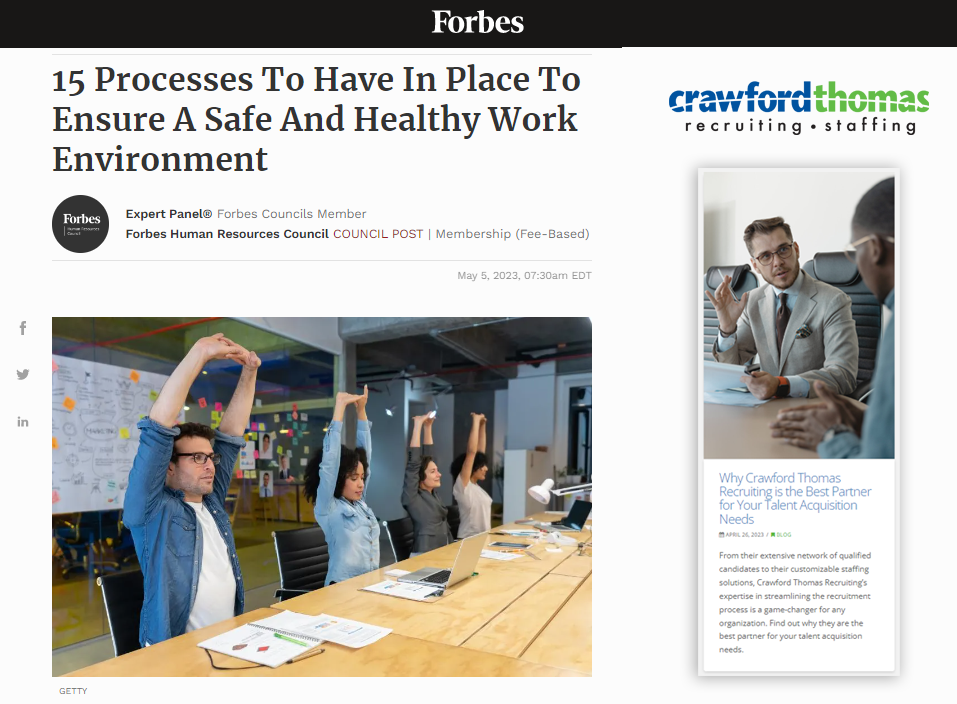As a business leader, it is important to prioritize the safety and well-being of your employees. Creating a safe and healthy work environment not only benefits your employees but also improves productivity and reduces costs associated with workplace injuries and illnesses. But how can you ensure that your workplace is safe and healthy?
Here, Forbes Human Resources Council members provide the processes that every business leader should have in place to promote a safe and healthy work environment. From risk assessments to training and communication, these processes will help you create a workplace that prioritizes the well-being of your employees.
Original article here.
1. Set Slack Channels For Informal Conversations
Informally, we spend a lot of time connecting one on one over walks and coffee and in our water cooler chat described as “all vibes, no agenda.” This helps people build trust and relationships. We use a platform with a monthly stipend for wellness apps and fitness classes. And our newest Slack channel is dedicated to #WellnessWednesdays where we share tips on how to take care of yourself. – Mikaela Kiner, Reverb
2. Define And Measure Your Safety Goals
It’s critical to set standards for a safe and healthy work environment. Define what that means for your organization, and what your goal is for a safe and healthy work environment. Then, measure it on a quarterly basis and build an action plan to show continuous improvement. In a warehouse, you might want to measure safety incidents and a continuous improvement plan to ensure better metrics. – Rohini Shankar, Nations Benefits
3. Help Employees Mitigate Stress
The first key to creating a healthy work environment is ensuring employees feel emotionally safe. While stress can never be completely eliminated from any job, it can be mitigated in a supportive work culture that does not tolerate toxic behavior. Second, employees must be given a voice to speak up when feeling overwhelmed, and management should be available to provide feedback and encouragement. – John Feldmann, Insperity
4. Train New Hires And Update Trainings Annually
I believe that training is the key to ensuring a safe and healthy work environment and that is why it is a critical component that all of our new hires must go through. The training could be updated annually and can be company or position specific to ensure mindfulness and awareness measures are taking place. – Omar Alhadi, Adobe Care and Wellness
5. Develop An Educational Platform
Considering legislative industry standards, every company should have an educational platform to ensure that all safety laws and procedures are understood by their employees and adhered to. A clear understanding of the safety competencies should be embedded in development plans. Preventative measures and a risk evaluation are the key components of a safe work environment. – Dr. Nara Ringrose, Aquila Nuclear Engineering
6. Promote Healthier Initiatives
Create a culture by design, focusing on processes promoting these initiatives, such as Step 1: Risk assessment to assess, identify and eliminate potential hazards. Step 2: Develop and implement policies to create a safe and health-focused workplace. Step 3: Train to educate benefit and imbibe as a way of life. Step 4: Governance to monitor and evaluate its effectiveness and identify areas for improvement. – Raj Tanwar, Advantage Club Technologies Private Limited
7. Conduct Regular Safety Training
It’s essential for company leaders to be conducting regular safety training, performing risk assessments, promoting a culture of safety, providing personal protective equipment and implement safety protocols and procedures, such as ergonomic evaluations, workplace violence prevention and Covid-19 safety guidelines. We also encourage employees to report any safety concerns and take appropriate actions to address them promptly. – William Stonehouse, Crawford Thomas Recruiting
8. Have The Right Procedures In Place
We ensure we have our processes and procedures in place, such as our business continuity plan, injury and illness prevention plan, pandemic plans, and more, and are regularly reviewed and updated. We also have worker resource groups that focus on wellness, which drives conversations related to education, empowerment and normalization. We also have a monthly HR newsletter that highlights our benefits. – Erin ImHof, CertiK
9. Understand State-By-State Laws
Awareness of the laws on worker safety in each state is essential for multi-state employers. Especially in the age of remote work, employers need to understand the nuances of requirements in any state where they employ workers. Consultants and professional employer organizations are good resources to help ensure employers stay within the letter of the law. – Niki Jorgensen, Insperity
10. Maintain Transparent Communication
A healthy work environment is built on three pillars: 1. hire transparent, authentic and genuine professionals; 2. have structured upward feedback where senior management is evaluated by the team beyond other factors; 3. keep transparent and open communication within the team (more open channels, less private messages). – Nick Frey, Avomind
11. Empower And Value Employees
Authentically create an agnostic, psychologically safe team culture where all team members are empowered, valued and rewarded for courageous conversations. – Britton Bloch, Navy Federal
12. Celebrate Failures And Encourage Vulnerability
Companies well-poised for success are those that realize the power of psychological safety and teamwork in creating environments where individuals collaborate and share information. To create this environment, leaders must focus on building trust between and amongst employees. Celebrate failures, normalize mistake-making and embrace vulnerability. – Gianna Driver, Exabeam
13. Provide Opportunities For Growth
Fostering a positive company culture creates a positive work environment by promoting trust and open communication, recognizing employee contributions, establishing psychological safety and providing opportunities for growth and development. Promoting work-life balance encourages and allows employees to prioritize their mental and physical health. – Bryan Ignozzi, Executive Search
14. Conduct Regular Safety Inspections
Provide appropriate safety training and equipment, and establish clear emergency protocols. We encourage an open-door policy for reporting safety concerns and provide resources for employee wellness: mental health support and ergonomic workspaces and equipment. Our goal is to create a culture of safety and well-being for our team members. – Joseph Soares, IBPROM Corp.
15. Promote A Work-Life Balance
A safe and healthy workplace is an organization-wide responsibility of every leader. Practices include ensuring physical safety, a culture of respect, mental health support and promoting a balanced life. It also involves creating psychological safety through open communication and feedback in order to continuously improve processes and address concerns related to employee health and well-being. – Raven Lee, Scientific Games
Crawford Thomas Recruiting:

Crawford Thomas is a team of leading HR recruiters. We not only fill staffing needs, we partner with organizations to find out how their recruiting needs tie into their business objectives. Through this, we are able to meet your staffing needs in a way that achieves organizational success.
Start securing top talent by visiting our page for employers today.

